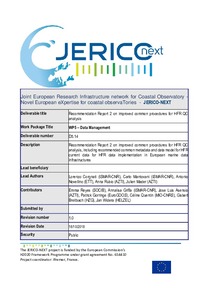Notice
This is not the latest version of this item. The latest version can be found at: https://repository.oceanbestpractices.org/handle/11329/1441.2
Recommendation Report 2 on improved common procedures for HFR QC analysis. JERICO-NEXT WP5-Data Management, Deliverable 5.14, Version 1.0.
| dc.contributor.author | Corgnati, Lorenzo | |
| dc.contributor.author | Mantovani, Carlo | |
| dc.contributor.author | Novellino, Antonio | |
| dc.contributor.author | Rubio, Anna | |
| dc.contributor.author | Mader, Julien | |
| dc.coverage.spatial | European | en_US |
| dc.date.accessioned | 2020-11-10T21:54:37Z | |
| dc.date.available | 2020-11-10T21:54:37Z | |
| dc.date.issued | 2018 | |
| dc.identifier.citation | Corgnati, L.; Mantovani, C.; Novellino, A.; Rubio, A. and Mader, J. (2018) Recommendation Report 2 on improved common procedures for HFR QC analysis. JERICO-NEXT WP5-Data Management, Deliverable 5.14, Version 1.0. Brest, France, IFREMER, 82pp, (JERICO-NEXT-WP5-D5.14-V1.). DOI: http://dx.doi.org/10.25607/OBP-944 | en_US |
| dc.identifier.uri | http://hdl.handle.net/11329/1441 | |
| dc.identifier.uri | http://dx.doi.org/10.25607/OBP-944 | |
| dc.description.abstract | The JERICO network is constantly working to improve its core functionality, which is the ability to provide comprehensive observations of Europe’s coastal seas and oceans. This means integrating new, promising observing technologies that can expand its spatial and temporal reach. This effort must include a specific data management fully committed to inform end-users and stakeholders about the quality and reliability of the data routinely delivered. While building the JERICO-Nextproject, High Frequency Radar (HFR) systems were identified as particularly attractive technology tocomplete the JERICO network. HFR technology offers the means to gather information on surface currents and seastate over wide areas with relative ease in terms of technical effort, manpower and costs.HFR technology is rapidly expanding in Europe, as it is increasingly used to support decision-making by coastal ocean users and managers, and its current and wave data will be operationally distributed by the main data distribution services, i.e. Copernicus Marine Environment Monitoring Service In Situ Thematic Assembly Center (CMEMS-INSTAC) and SeaDataCloud (SDC).Moreover, in the next years it is expected that HFR surface current data will be systematically ingested in dataassimilation processes necessary for predictive model adjustment. Thus, the unified implementation and coordination are needed for producing interoperable and high quality HFR datafor scientific and societal applications.Task 5.6 of JERICO-Nextproject deals specifically with defining common formats and Quality Control (QC) procedures for HFR data.A common data and metadata model and QC test battery for Near Real Time (NRT) current data from HFR were defined and implemented toensure efficient and automated data discovery andinteroperability across distributed and heterogeneousearth science data systems.Afirst recommendation at European level to achieve the harmonization of HFR data management was published within JERICO-Next deliverable D5.13 and in the INCREASE deliverable D3.1(http://www.cmems-increase.eu/static/INCREASE_Report_D3.1.pdf), defining data format, metadata structure, QC flagging scheme and QC tests.The data model and the basic set of QC tests defined in JERICO-Next D5.13 and recovered in CMEMS Service Evolution INCREASE project (deliverable D3.1) havebeen further analyzed and improved, also in synergy with the work performed in Task 3.2. The work has been performed within an extended group including scientists from the HF radar European community as well as from the US IOOS and the Australian ACORN networks. Additional QC tests with respect to the basic set have been defined and the data model has been refined accordingly, also aiming at the full integration of CMEMS-INSTAC and SDC requirements.This deliverable presents these improved recommendations that have been established taking into account: (1) the characteristics of HFR monitoring, considering that HFR surface current velocity data are somewhat unique in the oceanographic observation world since they are: i) two-dimensional ocean surface measurement; ii) derived from a fixed land-based remote sensor and iii) they are placed on a fixed grid;(2) the existing standards in non-EU networks (in particular in IOOS);(3) the existing standards in Europe for Marine Data Management (EuroGOOS DATAMEQ, EuroGOOS HFR Task Team, CMEMS, SeaDataNet’s NODC network, EMODnetand its thematic portals, JCOMMOPS in-situ Observing Platforms) | en_US |
| dc.language.iso | en | en_US |
| dc.publisher | IFREMER | en_US |
| dc.relation.ispartofseries | JERICO-NEXT-WP5-D5.14-V1.0; | |
| dc.subject.other | HF Radar | en_US |
| dc.title | Recommendation Report 2 on improved common procedures for HFR QC analysis. JERICO-NEXT WP5-Data Management, Deliverable 5.14, Version 1.0. | en_US |
| dc.type | Report | en_US |
| dc.description.status | Published | en_US |
| dc.format.pages | 82pp. | en_US |
| dc.description.notes | Contributors: Emma Reyes , Annalisa Griffa , Jose Luis Asensio , Patrick Gorringe , Céline Quentin, Gisbert Breitbach, Jan Widera | en_US |
| dc.publisher.place | Brest, France | en_US |
| dc.subject.parameterDiscipline | Parameter Discipline::Physical oceanography::Currents | en_US |
| dc.subject.instrumentType | Instrument Type Vocabulary::radar altimeters | en_US |
| dc.subject.dmProcesses | Data Management Practices::Data quality control | en_US |
| dc.description.currentstatus | Current | en_US |
| dc.description.sdg | 14 | en_US |
| dc.description.eov | Surface currents | en_US |
| dc.description.maturitylevel | TRL 9 Actual system "mission proven" through successful mission operations (ground or space) | en_US |
| dc.description.bptype | Manual (incl. handbook, guide, cookbook etc) | en_US |
| obps.contact.contactname | Lorenzo Corgnati | |
| obps.contact.contactemail | lorenzo.corgnati@sp.ismar.cnr.it | |
| obps.resourceurl.publisher | https://www.jerico-ri.eu/download/jerico-next-deliverables/JERICO-NEXT-Deliverable_5.14_V1.pdf | en_US |
 Repository of community practices in Ocean Research, Applications and Data/Information Management
Repository of community practices in Ocean Research, Applications and Data/Information Management
